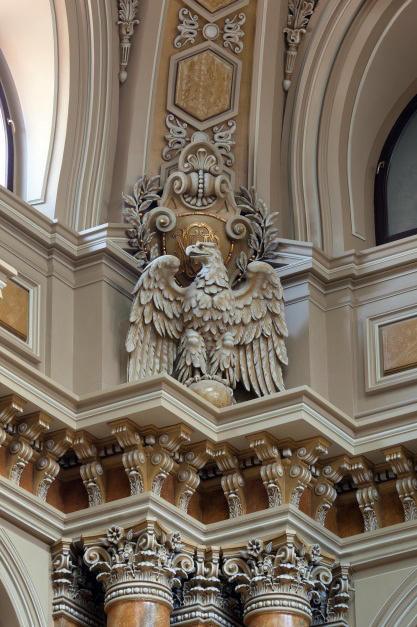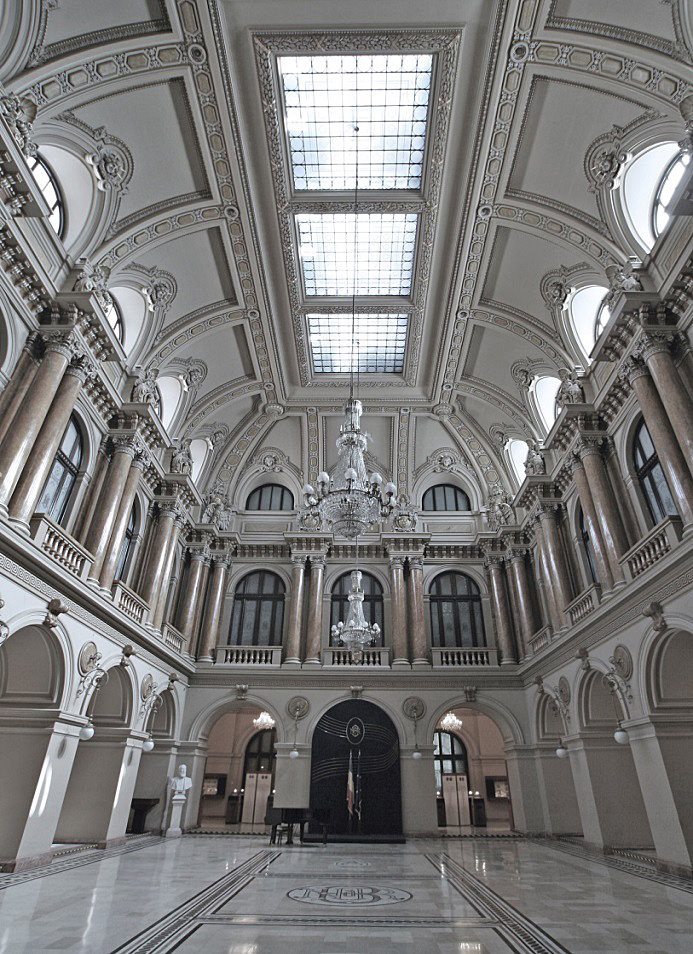The National Bank of Romania preserves a valuable architectural heritage, comprising two palaces where the bank has its headquarters, included on the list of national historical monuments.

The Old Palace, view from Lipscani Street
The Old Palace of the National Bank, considered “the most beautiful building in Bucharest” by architect Ion Mincu, impresses through its monumentality, regularity, distinction and size. The contrasting interior, with an “ample and spectacular configuration that is very well contained” (architect Nicolae Lascu), is suited to the esthetic and functional needs of a central bank at the end of the 19th century. It is the first important bank building in Bucharest, the most imposing building of a financial institution, which can be compared with other great constructions of the time in European capitals.

Interior detail
The contrast between the strictness and un-ostentatiousness of the facades’ architecture and the decorative richness of the interior is evident. Therefore, both public spaces on the ground floor and the representation spaces on the first floor surprise the visitors, due to a remarkable visual and decorative concept.
A century later, the modernization and development of banking activities rendered the initial destination of the ample and lavishly decorated work spaces on the ground floor improper to the activity of bank clerks. Therefore, their artistic and symbolic value led to the spaces’ conversion into a museum for the use of the wider public. The visitors discover an unexpectedly generous space, richly adorned and framed by columns and pillars, where the Museum of the National Bank of Romania is presently established.

The Marble Hall, the former hall of counters
The museum’s central element is the former hall of counters, which goes today by the name of “The Marble Hall”, the largest hall in the Old Palace, two levels tall, reaching up to the building’s first floor.
The ground floor displays a series of massive pillars, with archways where the counters for client relations used to be placed. A vault is embedded in each pillar, used by the clerks for their day-to-day activities. The first floor displays double columns, connected through small communication loggias to the gallery upstairs, from where the daily commercial activities in the hall and at the counters could be directly and discretely watched.
The architecture of the counters’ hall is subordinate to its purpose and is characteristic to 19th century European banks. It brings to mind the banks and stock exchanges of the 16th-17th centuries, with an area for money exchange around a rectangular, uncovered, little square type space, outlined by the building’s ground floor and first floor.
A special mention should go to the hall’s acoustics, which are broken in the centre and clear all around the room. They had been especially designed to keep the secrecy of bank operations, a forerunner of the discretion line in present-day commercial banks. The resulting echo was meant to ease communications between bank clerks and their clients.
Showcasing the numismatic exhibition in the lateral aisles of the Marble Hall was meant as a minimal intervention in terms of layout, in order to preserve the authenticity of the construction and for a balanced coherence between architecture and the displayed exhibits. The central area of the hall, thus, keeps up its own tune.